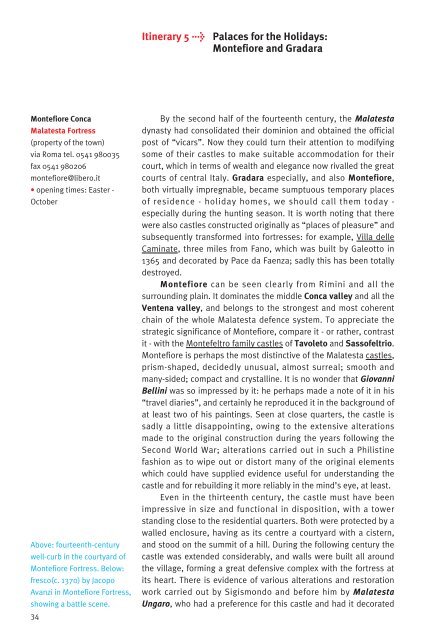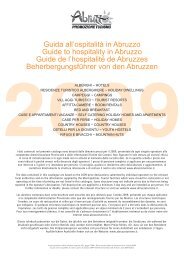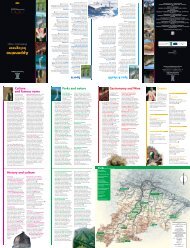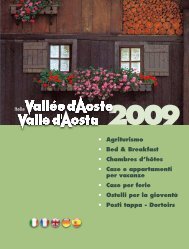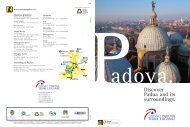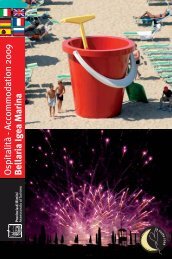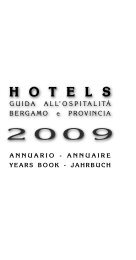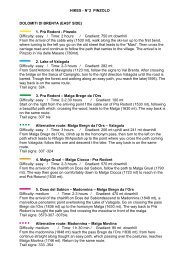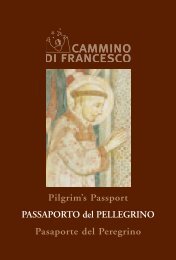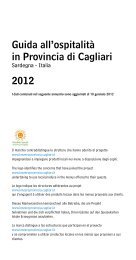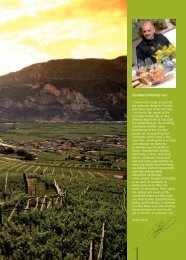Malatesta fortresses and castles
Malatesta fortresses and castles
Malatesta fortresses and castles
You also want an ePaper? Increase the reach of your titles
YUMPU automatically turns print PDFs into web optimized ePapers that Google loves.
Itinerary 5 ><br />
Palaces for the Holidays:<br />
Montefiore <strong>and</strong> Gradara<br />
Montefiore Conca<br />
<strong>Malatesta</strong> Fortress<br />
(property of the town)<br />
via Roma tel. 0541 980035<br />
fax 0541 980206<br />
montefiore@libero.it<br />
• opening times: Easter -<br />
October<br />
Above: fourteenth-century<br />
well-curb in the courtyard of<br />
Montefiore Fortress. Below:<br />
fresco(c. 1370) by Jacopo<br />
Avanzi in Montefiore Fortress,<br />
showing a battle scene.<br />
34<br />
By the second half of the fourteenth century, the <strong>Malatesta</strong><br />
dynasty had consolidated their dominion <strong>and</strong> obtained the official<br />
post of “vicars”. Now they could turn their attention to modifying<br />
some of their <strong>castles</strong> to make suitable accommodation for their<br />
court, which in terms of wealth <strong>and</strong> elegance now rivalled the great<br />
courts of central Italy. Gradara especially, <strong>and</strong> also Montefiore,<br />
both virtually impregnable, became sumptuous temporary places<br />
of residence - holiday homes, we should call them today -<br />
especially during the hunting season. It is worth noting that there<br />
were also <strong>castles</strong> constructed originally as “places of pleasure” <strong>and</strong><br />
subsequently transformed into <strong>fortresses</strong>: for example, Villa delle<br />
Caminate, three miles from Fano, which was built by Galeotto in<br />
1365 <strong>and</strong> decorated by Pace da Faenza; sadly this has been totally<br />
destroyed.<br />
Montefiore can be seen clearly from Rimini <strong>and</strong> all the<br />
surrounding plain. It dominates the middle Conca valley <strong>and</strong> all the<br />
Ventena valley, <strong>and</strong> belongs to the strongest <strong>and</strong> most coherent<br />
chain of the whole <strong>Malatesta</strong> defence system. To appreciate the<br />
strategic significance of Montefiore, compare it - or rather, contrast<br />
it - with the Montefeltro family <strong>castles</strong> of Tavoleto <strong>and</strong> Sassofeltrio.<br />
Montefiore is perhaps the most distinctive of the <strong>Malatesta</strong> <strong>castles</strong>,<br />
prism-shaped, decidedly unusual, almost surreal; smooth <strong>and</strong><br />
many-sided; compact <strong>and</strong> crystalline. It is no wonder that Giovanni<br />
Bellini was so impressed by it: he perhaps made a note of it in his<br />
“travel diaries”, <strong>and</strong> certainly he reproduced it in the background of<br />
at least two of his paintings. Seen at close quarters, the castle is<br />
sadly a little disappointing, owing to the extensive alterations<br />
made to the original construction during the years following the<br />
Second World War; alterations carried out in such a Philistine<br />
fashion as to wipe out or distort many of the original elements<br />
which could have supplied evidence useful for underst<strong>and</strong>ing the<br />
castle <strong>and</strong> for rebuilding it more reliably in the mind’s eye, at least.<br />
Even in the thirteenth century, the castle must have been<br />
impressive in size <strong>and</strong> functional in disposition, with a tower<br />
st<strong>and</strong>ing close to the residential quarters. Both were protected by a<br />
walled enclosure, having as its centre a courtyard with a cistern,<br />
<strong>and</strong> stood on the summit of a hill. During the following century the<br />
castle was extended considerably, <strong>and</strong> walls were built all around<br />
the village, forming a great defensive complex with the fortress at<br />
its heart. There is evidence of various alterations <strong>and</strong> restoration<br />
work carried out by Sigismondo <strong>and</strong> before him by <strong>Malatesta</strong><br />
Ungaro, who had a preference for this castle <strong>and</strong> had it decorated


